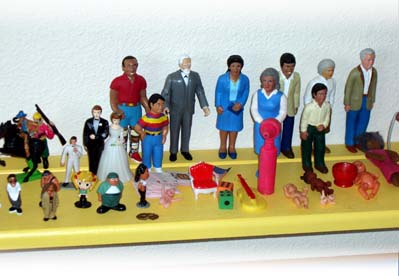|
COVER
STORY | IN THE NEWS | DIRT | ARTBEAT February 9, 2006Art therapyby KATHERINE ALMY
I've always known about the therapeutic power of creativity for myself, but I'd never really thought about it as a genuine tool for stress reduction. So when my husband pointed out a class to me from the HSU Extended Ed catalog, I was intrigued. "Play and Presence: Stress Reduction through the Arts," it's called. I made a few phone calls and got in touch with the instructor. "What's it all about?" I asked. According to her biography, Miriam Labes is a licensed professional counselor in New Mexico and is currently a Marriage Family Therapist (MFT) intern. She and her partner, Caren Wise, practice Expressive Arts Therapy at their newly opened Center for the Living Arts, on 11th Street in Arcata (www.livingartscenter.org). Apparently, Expressive Arts Therapy taps into those things I'd noticed about the effect creativity produces on the creator. As a recognized psychotherapeutic practice, expressive arts therapy is fairly new. My sense of it is that it really began to take off in the '70s. In her book The Creative Connection, Natalie Rogers, internationally known psychologist and expressive arts therapist, states that, "part of the psychotherapeutic process is to awaken the creative life-force energy. Thus, creativity and therapy overlap." In practices where therapists were helping people express deep, possibly buried, emotion, it became apparent that creative activities such as journal writing, dance, improvisational drama, sculpture, painting and drawing were far more productive than just talk. It is important to note that in expressive arts therapy, the focus is taken off the product; it's the process that counts. You don't have to be an Artist, you're not producing anything you're going to try to sell (although you may be surprised with the quality of the results). The important thing is to enjoy the process of creating and let it open up new patterns for you. Miriam states that "the expressive arts can help provide an opportunity to create new experiences beyond habitual patterns and can foster renewed ability to relax." The practice has a broad range of applicability, and Miriam and her partner offer therapy to individuals, groups, families and children dealing with issues of grief, depression and personality disorders, to name a few. For myself, I recognized its possibilities for children immediately, when I visited her office with my 2-year-old. He was happily absorbed with her sandbox and shelves and shelves of little toys while she and I chatted for a good half-hour. Another intriguing project she's got going is a workshop in Israel, which will bring together Palestinian and Israeli women political activists in order to "stimulate new forms of self-understanding and communication." So what will the HSU workshop on Saturday and Sunday, Feb. 18 and 19, be like? (Call the Extended Ed office now to register.) What can one expect? It's not that easy to describe. Because it's participant-driven, it morphs every time Miriam does one, depending on the dynamic of those who show up. But here's a rough outline. Day One will start with introductions and building "group safety." Since we're talking about expressing ourselves, it's important to establish some trust. Then you'll move onto some body awareness exercises to get you out of your head and into your body. The themes for the weekend are "renewal and self-nourishment," and you'll be working with writing, movement and visual arts to express these themes. On Day Two, you'll learn more about the expressive arts process as a tool for self-healing. You'll write about your experience and create your own unique plan for self-care. Thus, the workshop is helpful in the long term, as you can start using the things you learn in your everyday life. Finally, there will be a period for feedback and reflections on the workshop. In my mind, this is a way for those who don't think of themselves as artists to benefit from the healthful and rejuvenating properties of the creative process. All of those "I don't have a creative bone in my body" types can start to recognize their own artistic side and reap the benefits of creativity in their daily lives.
Got a local exhibit or art event that might make a good story? Send your art news to [email protected] or write in care of the North Coast Journal, 145 South G Street, Suite A, Arcata, CA. 95521. COVER
STORY | IN THE NEWS | DIRT | ARTBEAT Comments? Write a letter! © Copyright 2006, North Coast Journal, Inc. |


 I
learned to crochet when I was about 10 years old, and I've been
doing it ever since. My best friend used to laugh at me and ask
me why I did that "Grandma stuff," but I didn't let
that stop me. My Aunt Alison was impressed with my dedication
to the craft and she recognized why I was so avid about it. "It's
like therapy, isn't it?" I didn't even really know what
therapy was at the time, but I knew she was right. The world
went away when I was engrossed in a project. I did my best thinking
then. It was relaxing while I was working and satisfying when
I completed a project.
I
learned to crochet when I was about 10 years old, and I've been
doing it ever since. My best friend used to laugh at me and ask
me why I did that "Grandma stuff," but I didn't let
that stop me. My Aunt Alison was impressed with my dedication
to the craft and she recognized why I was so avid about it. "It's
like therapy, isn't it?" I didn't even really know what
therapy was at the time, but I knew she was right. The world
went away when I was engrossed in a project. I did my best thinking
then. It was relaxing while I was working and satisfying when
I completed a project.